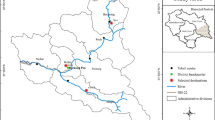Abstract
The development of the Munich Rapid Transit System, coupled with the growth of the Munich region, has had a major effect on the spatial structure of the region. The radial form of the rapid transit system has led to an outward movement of higher income families and a strengthening of the service function of the city centre, to the cost of local centres. Lower income families are tending to settle in the city centre fringe areas, although their primary employment opportunities, in manufacturing industry, are increasingly moving to the urban fringe. There is, thus, a growing spatial separation between homes and workplaces and although the rapid transit system has reduced traffic congestion in Munich, it has encouraged the development of an urban structure which is not compatible with the objectives of either the state or the region.
Similar content being viewed by others
Author information
Authors and Affiliations
Rights and permissions
About this article
Cite this article
Kreibich, V. The successful transportation system and the regional planning problem: An evaluation of the Munich rapid transit system in the context of urban and regional planning policy. Transportation 7, 137–145 (1978). https://doi.org/10.1007/BF00184636
Issue Date:
DOI: https://doi.org/10.1007/BF00184636




